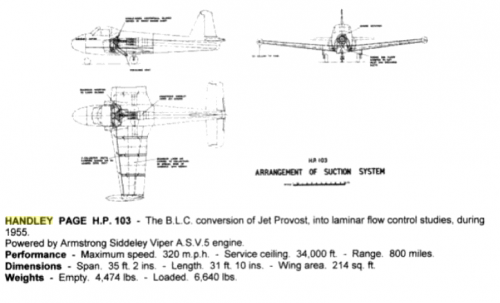- Joined
- 26 May 2006
- Messages
- 34,916
- Reaction score
- 15,790
Hi,
the Handley Page HP.103 was a conversion of Jet Provost,into a laminar flow control
studies during the 1955,it was powered by one Armstrong Siddeley Viper A.S.V.5
engine.
https://books.google.com.eg/books?id=L-k5AwAAQBAJ&pg=PA101&lpg=PA101&dq=Handley+Page+HP.130+aircraft&source=bl&ots=Qzx2ylsC6b&sig=HuQvGZ81entOPH4yNqyPvok1XcM&hl=ar&sa=X&ei=A76vVLW1A47saPnbgIgE&ved=0CFkQ6AEwCg#v=onepage&q=Handley%20Page%20HP.130%20aircraft&f=false
the Handley Page HP.103 was a conversion of Jet Provost,into a laminar flow control
studies during the 1955,it was powered by one Armstrong Siddeley Viper A.S.V.5
engine.
https://books.google.com.eg/books?id=L-k5AwAAQBAJ&pg=PA101&lpg=PA101&dq=Handley+Page+HP.130+aircraft&source=bl&ots=Qzx2ylsC6b&sig=HuQvGZ81entOPH4yNqyPvok1XcM&hl=ar&sa=X&ei=A76vVLW1A47saPnbgIgE&ved=0CFkQ6AEwCg#v=onepage&q=Handley%20Page%20HP.130%20aircraft&f=false

